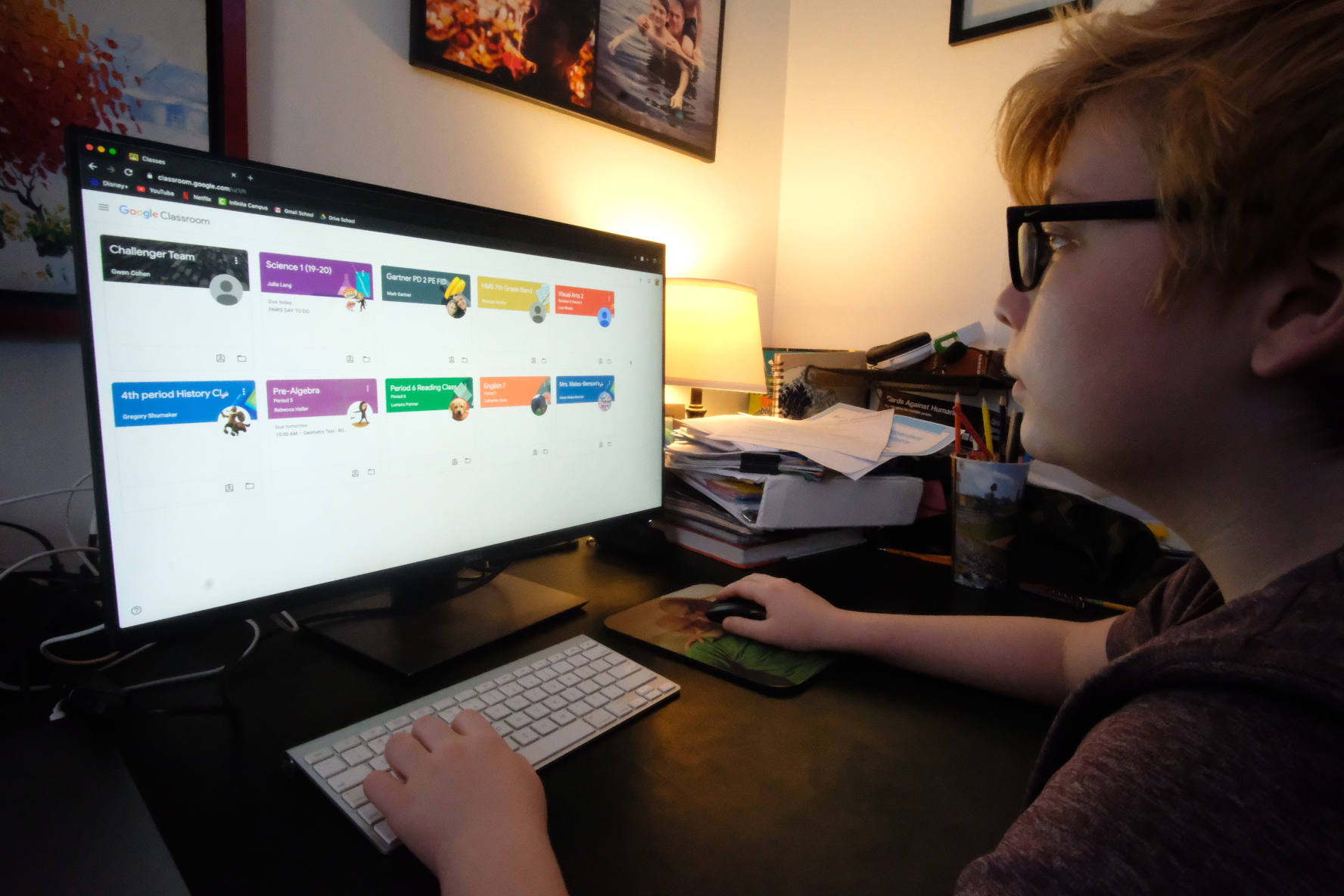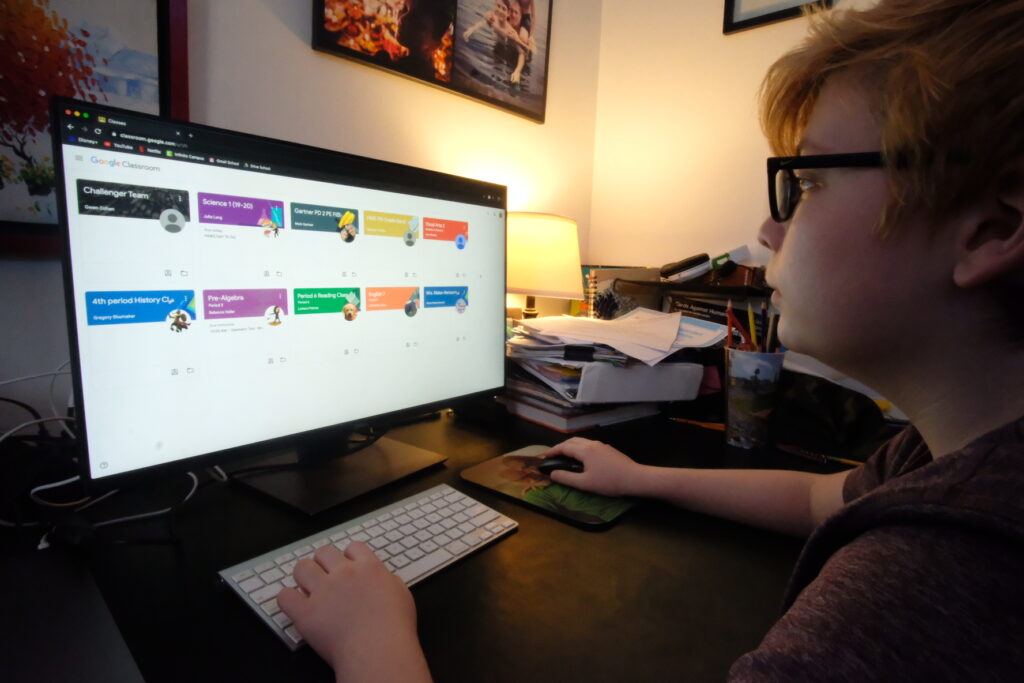Without warning or training, millions of parents are now guiding their children through their daily education during quarantine. Sequestered in our homes, we sort through digitized worksheets and Google forms, screen Youtube videos and dial our kids into Zoom lectures on topics we may barely remember from our own school days.
Nonprofits, education companies and even individual artists are here for us: Kids are sketching with Mo Willems, reading with Levar Burton and even listening to Patrick Stewart read Shakespeare’s sonnets via Twitter each day. Parents fortunate enough to have a solid wifi connection are likely grateful — but also a bit unsure how to manage this sudden flood of resources.
“As someone who works on the issue of education innovation and looks at the role of technology in education innovation, I’m overwhelmed,” says Rebecca Winthrop, co-director of the Center for Universal Education at the Brookings Institution. “I can only imagine that for people who are not in the educational sector, it is super overwhelming.”
Beyond choosing the right resources, we may worry that our kids seem to be getting too few assignments — or perhaps too many. As we juggle all the other challenges related to COVID-19, how can we best sort through all these options to help our learners?

Focus on key skills with help from trusted sources
Windy Lopez-Aflitto, vice president of content and partnerships at Learning Heroes, says parents don’t need to worry about trying to teach their child’s full curriculum. Instead, she says, focus on their foundational math and reading skills.
For K-8 learners, she says, the Learning Heroes Readiness Check can confirm grade-level skills. The free service, available in English and Spanish, will assess a child’s skills and suggest any additional learning support that’s needed. Then it guides you to trusted sources, including IXL and Khan Academy.
“Although this is such a stressful time for both parents and teachers,” Lopez-Aflitto says, “it’s also a chance to catch up.” Parents can use the Readiness Check “to see how their child is doing,” she says, “and share that information with their child’s teacher.”
For students of any age, Khan Academy can supplement learning in most any subject.
“They have daily schedules for kids ages 2 to 18,” says Dr. Bart Rocco, who served as superintendent of the Elizabeth Forward School District and is currently a Grable Foundation Fellow. “Parents do have to register,” he says, but they’ll then receive free access to courses tailored to their child’s needs in math, science, history, English and more.
Another great resource: Common Sense Media’s Wide Open School. They’ve curated offerings from the top education companies and nonprofits to provide “everything there from ‘Here’s how to create a schedule for your child’ to ‘Here are some social-emotional learning apps,'” says Winthrop.
Create a basic routine
To keep a sense of consistency, create a routine with your child that shares some components with their traditional school day, says Lopez-Aflitto. At her own home, she wrote out an initial schedule with blocks of time in the morning for math and reading, plus breaks throughout the day.
“Focus on the morning time,” Lopez-Aflitto advises, “when kids are most alert.”
Her 5-year-old daughter has now taken on the job of writing out a schedule for each day, which gives her a sense of ownership, and she’s using the same term she hears at school. “When we have our break time,” Lopez-Aflitto says, “we call it recess.”
Take time to teach internet safety
With many students spending their days online, “this is a great time to talk about safety on the internet,” says Dr. Bille Pearce Rondinelli, a Grable Foundation Fellow and former assistant superintendent for the Pine-Richland School District and associate superintendent for the Shaler Area School District.
Dr. Rondinelli and Dr. Rocco point out that students must get a learner’s permit and spend hours training in order to drive a car. They promoted a similar approach to internet use in the districts where they’ve worked. To help with that, “Common Sense Media has a very robust activity framework around how kids can manage sites and how they can make sure that they’re not invalid or improper,” Dr. Rocco says.
Along with safe surfing, be sure to remind students to step away from digital devices for a portion of each day. Moving their bodies in the real world and getting regular exercise is also important, says Winthrop.
Help kids explore one specific interest
Especially if kids are spending fewer hours on school and homework, help them pursue an area of interest: “Ask the kids,” says Winthrop. “What’s a passion that they want to explore? What’s a skill they want to develop?”
Kids who love cooking or baking can seek out free online recipes and classes, while kids who love tech can explore MIT Scratch or code.org.
Parents can also plan a “virtual fieldtrip” to a museum or a city their student would love to visit someday, says Rondinelli. Whatever their interest, she says, “this is a wonderful time for students to be able to take something that they know to a different level.”
Students can also use a hobby or area of interest to remain connected to friends. Kids can pursue an interest together, like building a city in Minecraft. And the time a student spends collaborating with a friend can also give their parents a chance to do their own work from home or handle other responsibilities.
Trust that your district will adapt
Schools have had to switch incredibly quickly to online learning or other forms of distance learning, says Winthrop. So much of what they’re providing right now “may not really the best of online learning.”
It’s “not that easy to transfer fabulous teaching skills in a live classroom to online,” Winthrop says, but schools are working hard to adapt and build their skills. So parents can assume that distance learning will improve over the coming weeks.
Along the way, trust yourself: This new experience will become more familiar and more manageable. Even if they don’t seem busy right now, students may be building new skills, new curiosity and even a new appreciation for classroom learning.
“It is okay, as parents, to let our kids have some space and time. Let them get a little bored,” Winthrop says. “That is when kids become super creative.”
